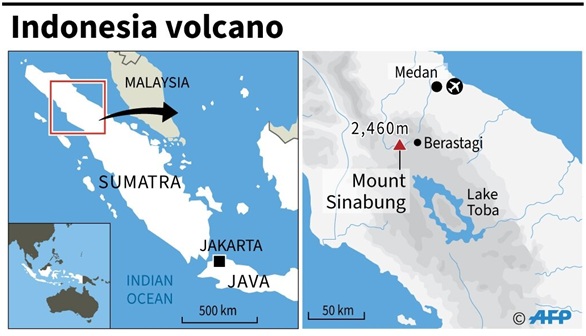

Indonesia’s Mount Sinabung erupted in a massive column of volcanic ash and smoke 3,000 metres (3 km) into the sky.
Context
Indonesia’s Mount Sinabung erupted in a massive column of volcanic ash and smoke 3,000 metres (3 km) into the sky.
About
About the Mount Sinabung
- Indonesia is home to many active volcanoes because of its location in the “Ring of Fire” or the Circum-Pacific Belt.
- Ring of Fire is an area along the Pacific Ocean and is characterized by active volcanoes and frequent earthquakes.

-
- The Ring of Fire is home to about 75 per cent of the world’s volcanoes and about 90 per cent of earthquakes.
- Mount Sinabung is a Pleistocene-to-Holocene stratovolcano of andesite and dacite in the Karo plateau, North Sumatra, Indonesia.
- It is 40 kilometres from the Lake Toba supervolcano.
- The volcano has been active since 2010 when it erupted after nearly 400 years of inactivity.
Why does a volcano erupt?
- There are three types of volcanoes: active, dormant or extinct.
- An eruption takes place when magma rises to the surface. It is a thick flowing substance and formed when the earth’s mantle melts.
- As magma is lighter than the rock, it is able to rise through vents and fissures on the surface of the earth. After its eruption, the magma is called lava.
- Not all volcanic eruptions are explosive as the explosivity depends on the composition of the magma.
- When the magma is runny and thin, the gases can easily escape it. In this case, the magma will flow out towards the surface.
- When the magma is thick and dense, gases cannot escape it, which builds up pressure inside resulting in a violent explosion.
Risks from eruptions
- Volcano causes suffocation that makes people susceptible with respiratory conditions such as asthma and other chronic lung diseases.
- Volcanic eruptions can result in additional threats to health such as floods, mudslides, power outages, drinking water contamination and wildfires.



